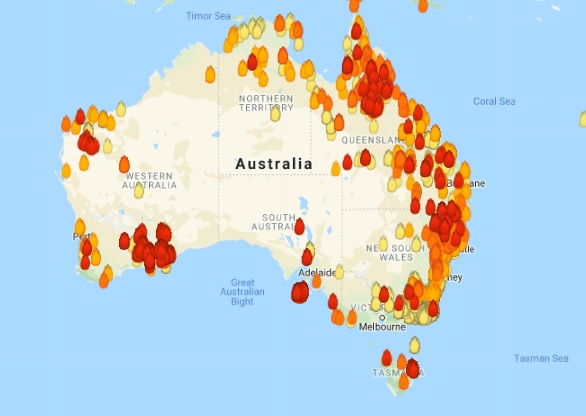Just a few days into the new year, the drums of war are beating over Iran. I’ll have more to say about that, but first: the southern hemisphere summer is just beginning, and Australia is burning on an apocalyptic scale. MyFireWatch, a website run by the Australian government, shows the magnitude of the disaster:

Bushfires are part of Australia’s ecology, but record-breaking hot, dry weather, intensified by climate change, has created monster wildfires on a scale never before witnessed. In the nation’s most populous states of New South Wales and Victoria, hundreds of fires are burning. Sydney and Melbourne are blanketed in smoke so thick it’s setting off fire alarms. The smoke plumes stretch to New Zealand, 1,200 miles away.
In the coastal town of Mallacoota, the navy was mobilized to rescue people huddling on the beach for refuge from the flames. Roads out of the burning regions have become nightmarish twelve-hour traffic jams. By one estimate, between one-third and one-half of the population is affected, and as many as half a billion animals may be dead.
And to be clear, Australia isn’t a passive victim of climate change. It’s played a part in creating the crisis it’s facing.
Its economy is heavily dependent on fossil fuel extraction, especially coal, which it burns for energy domestically and exports to Asia. In the 1990s, the conservative John Howard government, like the contemporary George W. Bush government, refused to ratify the Kyoto Protocol. Australia has one of the largest per-capita carbon footprints in the world, behind only a few nations, most of them petro-states like Saudi Arabia.
At the same time, Australia has a lot more to lose from climate change than most countries. In a land that’s so arid to begin with, a shift toward hotter, drier weather could make the continent an uninhabitable desert. And since the vast majority of people live on a thin slice of coast, sea level rise is an inescapable threat. On a warming planet, Australians are trapped between fire and flood.
The only hope for Australia is to break its carbon addiction, end its fossil fuel exports and green its economy as rapidly as possible. But just when we urgently need brave, progressive politicians willing to state this hard truth, Australia – like the U.S., like the U.K. – is suffering from a leadership void. Its right-wing government is groveling at the feet of the fossil fuel industry, willing to burn the future on the pyre of short-term capitalism.
The writer Richard Flanagan makes this point in a scathing essay, “Australia Is Committing Climate Suicide“:
As I write, a state of emergency has been declared in New South Wales and a state of disaster in Victoria, mass evacuations are taking place, a humanitarian catastrophe is feared, and towns up and down the east coast are surrounded by fires, all transport and most communication links cut, their fate unknown.
…The bookstore in the fire-ravaged village of Cobargo, New South Wales, has a new sign outside: “Post-Apocalyptic Fiction has been moved to Current Affairs.”
And yet, incredibly, the response of Australia’s leaders to this unprecedented national crisis has been not to defend their country but to defend the fossil fuel industry, a big donor to both major parties — as if they were willing the country to its doom. While the fires were exploding in mid-December, the leader of the opposition Labor Party went on a tour of coal mining communities expressing his unequivocal support for coal exports. The prime minister, the conservative Scott Morrison, went on vacation to Hawaii.
We’ve been living grossly out of balance with the natural rhythms of this planet. This can’t go on, and unless we correct our course, nature will correct it for us – more painfully, more destructively, with many more deaths. What’s happening in Australia is a foretaste of that.